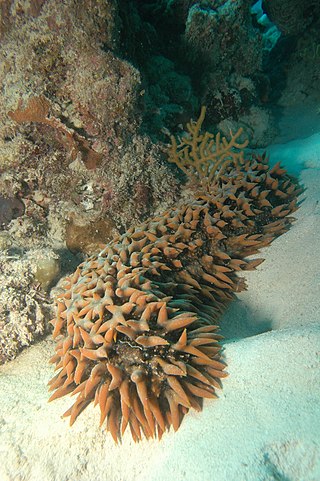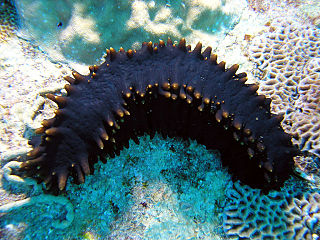
The California sea cucumber, also known as the giant California sea cucumber, is a sea cucumber that can be found from the Gulf of Alaska to Baja California. It is found from the low intertidal zone to a depth of 250 m (820 ft). They are most abundant in areas with moderate current with cobbles, boulders or bedrock. They are artisanally fished.

The word Gamat, the Malay word for sea cucumber, refers to medicinal remedies derived from several species of the Holothuroidea family.

The Stichopodidae are a family of sea cucumbers, part of the order Synallactida.

Australostichopus is a genus of sea cucumbers in the family Stichopodidae. It is monotypic, being represented by the single species Australostichopus mollis, commonly known as the brown sea cucumber or Australasian sea cucumber. This species has stimulated interest for its fishery potential in the Southern Hemisphere, and for its capability to reduce waste produced by aquaculture. Despite its ecological role and abundance in New Zealand coastal waters, the scarcity of knowledge regarding A. mollis biology and ecology has hindered the development of a stable fishery industry. Importantly, A. mollis represents promising business potential within an important Asian market. Recently its potential as a functional food has been evaluated, highlighting the nutritious components

Stichopus chloronotus is a species of sea cucumber. Common names include the greenfish sea cucumber, the spiky sea cucumber and the black knobby sea cucumber. It is native to the Indo-Pacific region. It has a wide range and is abundant and the IUCN lists it as being of "Least Concern".

Stichopus horrens is a variable, grey to green/black sea cucumber from the Indo-Pacific. It is often variegated with dark patches. It is a medium-sized species with a smooth tegument but large and irregular papillae. The big tubercles and irregular body form give an "irregular, soft and almost repulsive" appearance. Spicules are tables and large "C" bodies. S. horrens many be found on reefs, below rocks on flats.

Stichopus is a genus of sea cucumbers from the family Stichopodidae.
The silver pearlfish, Encheliophis homei, is a species of eel-like fish in the family Carapidae. This pearlfish lives inside the coelom of sea cucumbers such as Bohadschia argus, Thelenota ananas , and Stichopus chloronotus. It is native to tropical and subtropical parts of the Indo-Pacific Ocean.

Synallactida is a rankless clade of sea cucumbers, but is referred to as an order. Taxa within Synallactida were previously classified in an order called Aspidochirotida, which was determined to be polyphyletic in 2017.

Stichopus herrmanni, or Herrmann's sea cucumber, is a species of holothuroidean echinoderm in the family Stichopodidae. It is found in the tropical, western Indo-Pacific Ocean, at depths down to 20 m (66 ft). This and several other species are known as curryfish and are harvested commercially; it is called gama in Indonesia.

Stichopus vastus is a species of sea cucumber in the family Stichopodidae. It is found on the seabed in the tropical, western Indo-Pacific Ocean.

Stichopus ocellatus is a species of sea cucumber in the family Stichopodidae. It is found on the seabed in the tropical, western Indo-Pacific region.
Stichopus rubermaculosus is a species of sea cucumber in the family Stichopodidae. It is found on the seabed in the tropical, western Indo-Pacific region.

Stichopus noctivagus is a species of sea cucumber in the family Stichopodidae. It is found on the seabed in the tropical, western Indo-Pacific region.
"Citrimicrobium" is a Gram-negative, pleomorphic, and motile bacteria genus from the family Erythrobacteraceae with one known species. Citrimicrobium luteum has been isolated from the gut of the sea cucumber Stichopus japonicus from the Jeju Island in Korea.
The Dr. K.K. Mohammed Koya Sea Cucumber Conservation Reserve is a marine protected area located off the coast of the Indian union territory of Lakshadweep, approximately 50 km (31 mi) northwest of the island of Bitra. Formally established by Indian authorities on February 27th, 2020, the reserve covers 239 km2 (92 sq mi) of the Arabian Sea, including parts of the Byramgore (Cheriyapani) Reef, and is the world's first conservation area specifically dedicated to the protection of sea cucumbers.
Stichopus naso is a species of sea cucumber from the family Stichopodidae











